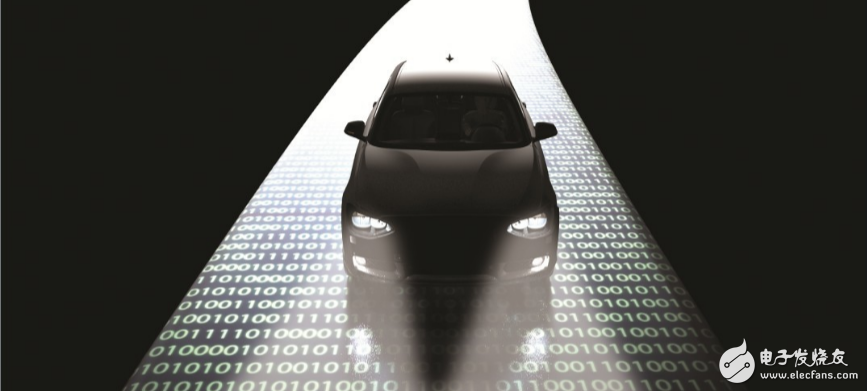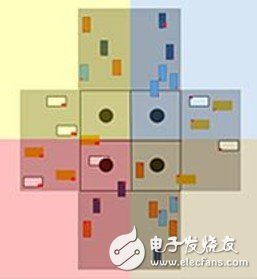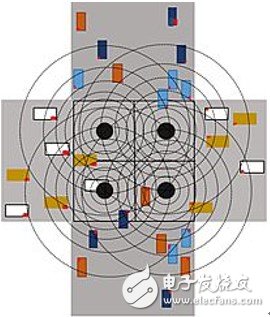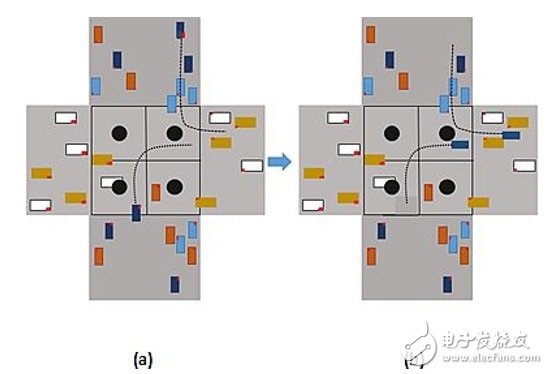MIT recently released a video about smart intersections. This kind of intelligent intersection can solve the traffic congestion queuing problem at the intersection without the need of traffic signals. This article will attempt to explain the capabilities of these smart intersections and how they can solve the problem of traffic queues at intersections.
Today Google Navigation can tell us all the information about traffic congestion on the road we want to pass. But the problem is that we have to ask ourselves, how does Google know this information? In fact, we are sharing this information with Google. People's concerns about data sensitivity and privacy will soon make them no longer share this information with Google. This is how to do? Fortunately, we already have the answer, the smart solar road. Traffic congestion is another such problem that the world's top technology companies have been trying to solve. MIT recently released a video about smart intersections. This kind of intelligent intersection can solve the traffic congestion queuing problem at the intersection without the need of traffic signals. This article will attempt to explain the capabilities of these smart intersections and how they can solve the problem of traffic queues at intersections.

Today, travel plans without Google Maps and Navigation are really hard to implement. Google Navigation can tell us which route we should take to reach our destination. It will remind us where the traffic is very congested and then we can re-plan the itinerary. How does Google do this? In fact, Google gets this information from people who are driving on that route. People like you or me share location information with Google, and Google uses some statistics based on some algorithm and the same Google map. Data can tell us about any congestion on the road. Today people are becoming more sensitive to data, and they will soon realize that this data sharing is another way to leak privacy. By that time, Google Navigation couldn't tell us about traffic congestion on all roads, so we needed to get the same information from different sources. There are two very smart researchers whose inventions will soon solve this problem. This article will discuss more about smart solar roads and how they can solve many of the problems we will soon face. Smart intersections are another component of a series of intelligent infrastructure entities that our future cities will have. This article will explain how these smart intersections work.
Current situation, problem descriptionThe challenge we face today is the growing traffic problems in urban areas. The population explosion caused by the improvement of the medical environment and the large number of immigrants moving to the city are the two main factors causing traffic problems. Google Maps or other navigation companies can accurately tell us about traffic on any route at any time, but we won't be able to help us in the future because they rely on data provided by road users. In addition, although these companies are still able to communicate with users about road conditions, any global solution to traffic congestion problems has not been effectively formed.
Despite the navigation application, today's traffic congestion problem is still very prominent. Most people prefer the shortest path to their destination. According to some statistics, if we consider wasteful time and unnecessary fuel consumption, the congestion problem causes us to spend about 2% to 4% of GDP. According to another analysis, researchers studying global traffic congestion believe that traffic congestion can be resolved if about 10%-15% of road traffic participants are required to re-route or change plans. But they need an algorithm to help them identify people who need to re-route at a certain point in time, which is the main problem.
Fortunately, there are more and more technologies that can solve most of the problems so far, and some future-oriented traffic problem solutions are also at your fingertips.
Recommended solutionSmart Solar Roads Solar Roads are smart infrastructure building blocks that provide us with different areas of traffic in the future when people decide not to share location information with Google. In fact, they are hexagonal solar panels that are spliced ​​together to form an entire road or any road surface such as a parking lot or park (Figure 1). These roads are very convenient for traffic flow detection because they are capable of detecting weight and they have built-in LEDs that illuminate when there are objects on them. Therefore, by calculating the number of LEDs that are lit at any time, the vehicle density on the road can be accurately estimated. Because these solar panels have built-in microcontrollers to control their behavior, these roads can actually communicate with the cloud, providing them with the traffic they are in.
Smart solar roads have many benefits. These roads have built-in solar panels so they can generate renewable electricity. These roads have built-in LEDs, so they can illuminate different patterns and instantly convert one-way three-lane to two-way four-lane. You can even draw a parking area on the road, and then clear the parking area when traffic is heavy. There are many other indication uses, so the roads themselves indicate that they are the smart infrastructure of the future. The configurable LED board converts the road to a basketball court for a certain period of time and then converts to a tennis court at some time. These roads can be part of a smart city infrastructure that will prove particularly useful for the foreseeable future.

Figure 1: A smart solar road made up of hexagonal solar panels that can be configured with LEDs.
The infrastructure that intelligent intersections can communicate with cars will be part of tomorrow's car networking. An intelligent intersection is such an infrastructure unit. If there is no traffic signal, will there be an accident? Or is there a better way to ensure that no accidents occur, and that traffic congestion and long queues are minimized? In fact, if the traffic signal is replaced by a smart intersection, then these problems will be solved.
Smart intersections typically have a built-in radar subsystem that can be used to detect cars that are close to the intersection. Each radar subsystem has a control area that the radar subsystem can detect and exchange information with when the vehicle enters the area (Figure 2). These subsystem components will continuously transmit radar signals to calculate the distance of the car from the intersection and the speed at which they approach the intersection (Figure 3). The third type of information that these components need to get from the car is the upcoming turnaround information. This information can be captured by the camera mounted on the radar subsystem to read the car's turn signal flashing signal, or by Wi-Fi communication between the car and the radar unit.
All of this information will be sent from these radar transceivers to the central processing unit (CPU) in the subsystem shared by all radar components (Figure 4). This CPU will perform the calculation and find two (or more) cars from different directions but want to enter the same lane and therefore may collide. Using the distance and speed data of the car and using the general steering trajectory data of the car at the pre-fed intersection, the CPU can predict any possible collision (Figure 5). After judging these cars that are about to collide, the CPU will command one of the cars to slow down. To do this, the CPU passes this information to the relevant radar subsystem, which then sends the information to the target car using a Wi-Fi signal (Figure 6). When one of the cars decelerates as required, the collision is avoided (Figure 7). Although this system is best suited for autonomous vehicles, it also supports well-connected, manually-driven cars.

Figure 2: Radar subsystems at intersections and their coverage areas.

Figure 3: The radar subsystem continuously transmits radar signals to calculate the distance of the car from the intersection and the speed at which they approach the intersection.

Figure 4: The radar subsystem at the intelligent intersection communicates with the CPU at the center of the intersection.

Figure 5: After receiving the information from the radar subsystem, the CPU can identify two cars that may have collided.

Figure 6: The CPU commands a radar subsystem to require one of the cars to slow down.

Figure 7: (a) Calculated decelerated travel trajectory; (b) How the collision is ultimately avoided.
Summary of this articleThe invention of smart car networking technology shows us the hope that the development of advanced technology in the world can help solve some complex problems. Smart cars and smart infrastructure together can solve many problems. Traffic congestion is one such problem, and it requires advanced technology to achieve a robust and durable solution. Smart roads and smart intersections are examples of the possibilities in the future. Tomorrow's smart city will have many of these smart infrastructure components that will unite to help us solve many problems.
This scratch-resistant TPU Film protects your new AirTag from daily wear and tear. It can be easily glued to the back to keep the shiny silver in its original condition. In addition, the AirTag screen protector with "self-healing" function can automatically repair small scratches and bubbles within 24 hours. This means you can continuously enjoy the new look and appearance of AirTag without worrying about serious scratches and dents.
The Apple Airtag TPU Film can perfectly fit your AirTag skin. It is designed to provide the maximum coverage for your AirTag metal panels. Compatible with most AirTag shells. Leave extra space around the frame so that your shell can wrap the edges of the AirTag without interfering with the film.
The 0.14mm ultra-thin AirTag Screen Protector allows you to enjoy the maximum resolution while being thin enough to make the AirTag sensitive to the original signal response, ensuring that it will not affect any user experience. You won't even notice that the screen protector is there, so your Apple logo can still be displayed.
The AirTag Tracker Screen Protector is very easy to apply and is specially designed for your AirTag. Just clean your AirTag and install it on the surface to eliminate all bubbles and get the job done!
Apple Airtag Screen Protector, Apple Airtag Screen Protective Film, Apple Airtag TPU Film, AirTag Tracker Screen Protector, Skin Wrap
Shenzhen Jianjiantong Technology Co., Ltd. , https://www.tpuprotector.com